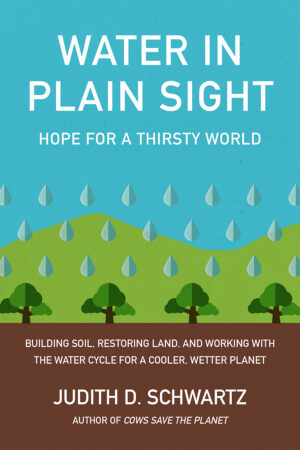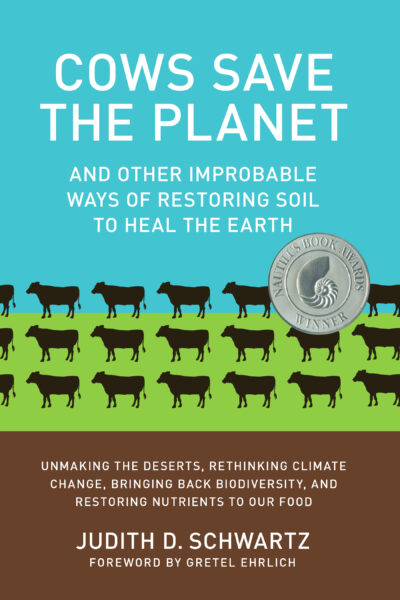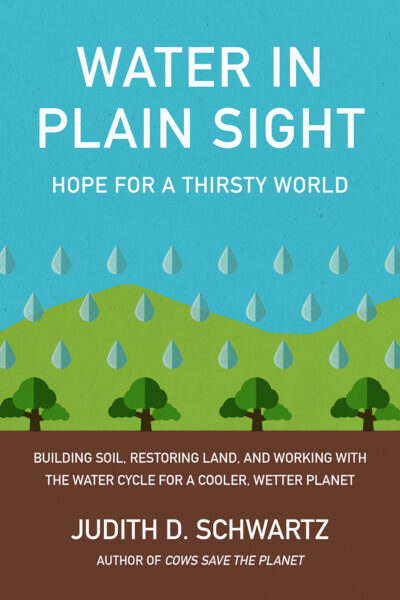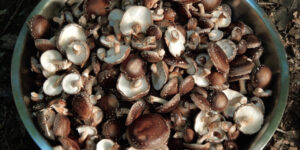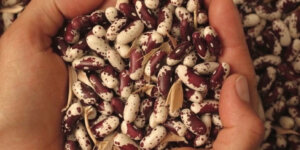Water Connects Us All

Water is always changing and impacting the environment around it; storms form, droughts occur, and floods damage. It seems that the level of water on Earth is bouncing between extremes. These shifts are tied to the state of our climate. In the past, climate change seemed like a far-off concept; now it’s becoming more present and concerning than ever.
The following is an excerpt from the Preface of Water in Plain Sight by Judith Schwartz. It has been adapted for the web.
Prefer audio?
Listen to the following excerpt from the audiobook of Water in Plain Sight.
The weather report promised sunshine, but Valencia, Spain, greets us with thunder and heavy rain. Water splashes on the sidewalks. Older women in sturdy shoes shake out their umbrellas, taking refuge in cafés. “The forecasters never get it right on the Mediterranean side, because they don’t consider the effects of the sea temperature,” explains Millán Millán, the Spanish meteorologist and atmospheric physicist I have come to visit.
Millán identifies the weather system as a ‘Levanter’, the Spanish coast’s equivalent of a ‘Nor’easter’, in which cold continental air encounters warm water and the result prompts intense precipitation. This typically plays out once the Mediterranean cools off, he says. He notes that as the sea has warmed some two degrees Celsius in the last thirty years, the region has experienced longer-lasting storms later into the season: “They used to end in October. Now they go all the way until June.” I reluctantly pocket my sunglasses and zip my rain-jacket up to my chin.
Millán, who until retirement led the Center for Environmental Studies of the Mediterranean (CEAM), is a longtime student of water-climate dynamics. On this edge of Spain that he knows so well, he can observe the movement of clouds and shifts of wind and estimate the arrival of rain within the hour. Over the past several decades he has documented the loss of the daily summer storms that once brought cool nights, cleansed the air, filled the aquifers, and were not so heavy as to spark flooding. He attributes their disappearance to development along the coast: specifically the loss of vegetation and soil, which has altered the hydrological cycle.
Millán speaks to the nuances of air and moisture flow with terms of the trade such as ‘advection’, ‘anticyclone’ and ‘inversion’. To a layperson it’s like this: Urbanization, the draining of marshes and the loss of forest cover has diminished water recycling in the Western Mediterranean Basin. As a result, the accumulated moisture piles up in layers over the sea or moves inland, causing torrential rains and mudslides elsewhere on the continent—such as those that have been hammering Central Europe—or out-of-season storms, like the one we are now contending with in usually sunny Valencia, squishing in our boots.
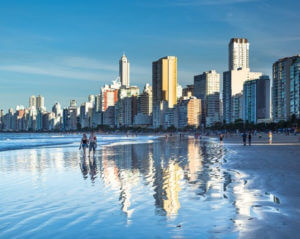 Millán’s research highlights a crucial insight that has yet to hit primetime: Our use of the land influences climate, and the vehicle for this is water.
Millán’s research highlights a crucial insight that has yet to hit primetime: Our use of the land influences climate, and the vehicle for this is water.
“Climate change has two legs: one on the ground and one in the air,” he says. “Land use changes alter the hydrological system, and this has immediate impacts on climate.” He calls the current focus on greenhouse gases “convenient”, Al Gore’s iconic phrase notwithstanding: “You can track CO2 a lot and do nothing about it.” What he means is that CO2 is abstract, and meaningful change depends on large entities like governments and industry. Land use, on the other hand, depends on where we live, what we eat, and how we move—the stuff of daily life. Understanding our individual and collective impact on the land prompts us to take responsibility on a deeper level, and to make deeper changes.
And yet herein lies opportunity: restoring the ecology in pivotal locations can reinstate water circulation and revive longstanding weather patterns. According to Millán, strategically re-vegetating a small expanse of land can make a significant difference in the surrounding region.
Since the first edition of Water In Plain Sight was published in 2016, we’ve seen a surfeit of droughts, heat waves, hurricanes and wildfires in North America and across the globe. Phrases like “unprecedented” and “record-breaking” hardly cut it anymore. A significant number of people suffer from trauma related to natural disasters and many more from a diffuse “climate grief”.
In this moment of ecological and climatic reckoning, it’s time to get real about water.
It’s time to get real about recognizing that the disruptions and anomalies often attributed to atmospheric CO2 are manifestations of distorted water cycles.
It’s time to get real about appreciating that water is at once a force that drives ecological processes and a product of them.
It’s time to get real about the fact that water is a verb as well as a noun, and that understanding how water “works”—how it moves across the landscape and through the atmosphere—will help us address many of our global challenges.
It’s time to get real about the water-climate connection, and to recognize that this offers agency. As Jean-Claude Oliva, director of Coordination Eau île-de-France said during COP 21 in Paris, “Water tends to be seen as related to the consequences of climate, but not as an inherent part of climate change. And yet, human activities have been affecting the water cycle in a way that is affecting climate change. This shows we can actually act on climate change through our water practices.”
Water connects us all.
It connects highlands and lowlands, and communities upstream to cities at the coast. Bodies of water transcend natural boundaries, and so create incentives for groups to cooperate and trade. Waterways offered a means of travel long before anyone dreamed of riding on wheels. And of course, water connects us socially: the universal gesture of peace and hospitality is to offer another person something to drink.
In this book, I strive to put water in context, to explore how water behaves and highlight water’s role in nature-based solutions. To do so I share stories of water innovators around the world who are finding new routes to water security—strategies and insights with important implications for food justice, economic resilience, biodiversity and climate change. These stories take us from Mexico to Africa to Australia, from deserts to mountains to rainforests.
We begin in Zimbabwe, in Southern Africa. Here, among the wild elephants and antelope and dusty, degraded landscapes, we’ll find revived rivers and pastures—and hope for a thirsty and unpredictable world.
Recommended Reads
Recent Articles
Garlic mustard: while known as “invasive,” this plant can be consumed in its entirety and has great nutritional value. Plus, the garlic-flavor is a perfect addition to any recipe that calls for mustard! The following are excerpts from Beyond the War on Invasive Species by Tao Orion and The Wild Wisdom of Weeds by Katrina…
Read MorePeregrine falcons, while known as predators, are essential to our environment. These stunning birds have a rich history, an interesting present, and an uncertain future. The following is an excerpt from Feather Trails by Sophie A. H. Osborn. It has been adapted for the web. Who Are Peregrine Falcons? Though relatively uncommon wherever it occurs,…
Read MoreWondering where to forage for greens this spring? Look no further than hedges, which serve as natural havens for wild greens and herbs! The following is an excerpt from Hedgelands by Christopher Hart. It has been adapted for the web. Food from Hedges: Salads and Greens Let’s start by looking at all the wild foods…
Read MoreInterested in becoming a mushroom farmer? Shiitake mushrooms are one of the easiest and most profitable places to start. The following is an excerpt from Farming the Woods by Steve Gabriel and Ken Mudge. It has been adapted for the web. (Photographs courtesy of Steve Gabriel and Ken Mudge unless otherwise noted.) The Stunning Shiitake…
Read MoreHow do you know if you’re picking the right seeds? Here are some easy tips on choosing the best seed crop for your environment. The following is an excerpt from The Organic Seed Grower by John Navazio. It has been adapted for the web. Seed Crop Characteristics There are a number of prominent characteristics of…
Read More

